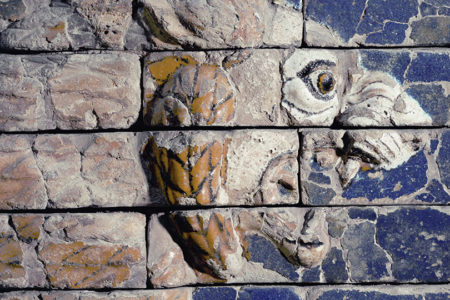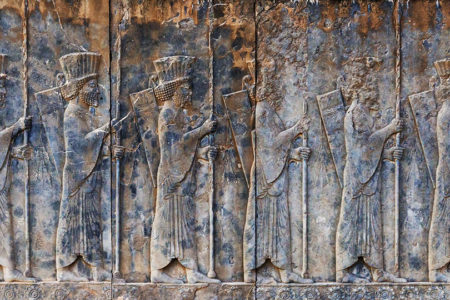The Second World Empire
On the evening of October 12, 539 B.C., a drunken party raged inside the city of Babylon. Belshazzar, son of King Nabonidus, emceed the event.
For the previous fourteen years, Belshazzar had enjoyed all of the perquisites of being coregent over the Neo-Babylonian Empire. But by the time the wine began to flow that evening, the Medo-Persian army under Cyrus II had overrun most of Belshazzar’s kingdom. Belshazzar’s own father had fled before the foreign juggernaut. And the enemy was literally at the gates.
This trouble did not deter Belshazzar. After all, the city of Babylon was heavily fortified with more than a hundred towers, a surrounding moat, and double walls. The inner wall alone was twenty-one feet thick.1
Overconfident, Belshazzar went too far. He and his guests drank their fill from the gold cups Nebuchadnezzar had taken from the Temple in Jerusalem years before, thumbing their noses at the invisible God of their Judean captives and praising their gods made of gold, silver, and other tangible substances.
Then divine judgment fell. That same evening, fingers like those of a man scrawled Belshazzar’s condemnation on a plaster wall of the king’s palace (Dan. 5:5). The prophet Daniel interpreted the writing, which declared the doom of Belshazzar and his kingdom. That same night God gave the kingdom to the Medes and Persians.
It happened exactly as God had said it would. Historians say the Medes and Persians diverted the waters of the Euphrates River, which ran down the middle of the city, and entered Babylon through the channel depression. They took the city without a struggle, killed Belshazzar, and ended the Babylonian Empire. The Persian Empire took its place and lasted two hundred more years, becoming the second world empire as prophesied by Daniel (Dan. 2:39; 7:5).
Cyrus II— First Return
After his forces took Babylon, Cyrus II, also called “the Great” (r.* 559–530 B.C.), entered the city on October 29, 539 B.C. to a liberator’s welcome. The people had disliked Nabonidus (Belshazzar’s father) because he had emphasized worship of the moon god, Sin, to the neglect of the popular Babylonian god, Marduk.
Cyrus treated the people well. He restored dilapidated buildings and created an atmosphere of peace. He also initiated the Persian policy of pluralism.
Instead of exerting dominance over foreign gods, he actively sought their beneficence, along with Marduk’s. He restored sacred objects, rebuilt sanctuaries, and repatriated exiles. An inscription on an ancient clay barrel, known as the Cyrus Cylinder, recorded Cyrus’s efforts:
I returned to (these) sacred cities on the other side of the Tigris, the sanctuaries of which have been ruins for a long time, the images which (used) to live therein and established for them permanent sanctuaries. I (also) gathered all their (former) inhabitants and returned (to them) their habitations.2
This inscription gives insight into Cyrus’s decree that allowed the Jewish people to return to Judah and rebuild the Temple (Ezra 1:1–4, 7). It also indicates that Cyrus’s kindness was not extended to them alone.
Nevertheless, behind the political move, God’s unseen hand was at work. Ezra the scribe wrote, “The LORD stirred up the spirit of Cyrus, king of Persia” (Ezra 1:1).
More than a hundred years earlier, through the prophet Isaiah, God foretold that a ruler named Cyrus would be His “shepherd” (Isa. 44:28) and “anointed” (45:1), who would “perform all my pleasure; even saying to Jerusalem, Thou shalt be built; and to the temple, Thy foundation shall be laid. He shall build my city, and he shall let go my captives” (44:28; 45:13).
The ancient historian Flavius Josephus believed it was by reading Isaiah’s prophecy that Cyrus’s spirit was stirred to allow the Jewish captives to return.3 Thus, some one hundred years before Cyrus was even born, God called Cyrus by name—an amazing prophetic testimony to the inspiration and authority of God’s Word. God’s sovereignty over Cyrus recalls Proverbs 21:1: “The king’s heart is in the hand of the LORD, like the rivers of water; he turneth it whithersoever he will.”
Thus in 536 B.C., under the leadership of Zerubbabel, about fifty thousand Jewish people returned to Jerusalem and laid the foundation of the second Temple. However, opponents frustrated their plans to complete the project. So the Temple lay unfinished for another twenty years.
Darius I — Construction Resumes
During that twenty years, power changed hands within the Persian Empire three times. Cyrus II died from a battle wound in 530 B.C. His son, Cambyses II (he is not mentioned in the Bible), ruled from 530 to 522 B.C. He died from an accident with his own sword.
Because Cambyses II left no heir, a usurper to the throne briefly held power. He was killed by Darius I (not Darius the Mede; see Daniel and Darius) and six Persian nobles. Darius I (r. 522–486 B.C.), himself not a direct heir to the throne, had to defeat nine rebellious kings within his first year to maintain power.
In 520 B.C. the prophets Haggai and Zechariah exhorted the returned exiles to begin work on the Temple again (Ezra 5:1). Darius ordered an inquiry, which unearthed Cyrus’s original decree. So Darius I granted them permission (Ezra 6:1–12).
Furthermore, he specified that anyone who tried to oppose the rebuilding project would be impaled (Ezra 6:11). Apparently, this was Darius’s common form of execution. The Greek historian Herodotus recorded that, after putting down a rebellion at Babylon, Darius took three thousand leading citizens and impaled (some translations say “crucified”) them.4 Because of Darius’s edict, the Temple was completed around 515 B.C.
Xerxes I— Marries Esther
Upon Darius’s death from an illness, his son Xerxes I, called Ahasuerus in Scripture, ruled over the Persian Empire (r. 486–465 B.C.).
At the beginning of Xerxes’ reign, enemies of the Jews in Judah wrote him “an accusation against the inhabitants of Judah and Jerusalem” (Ezra 4:6). Scripture does not give specifics regarding the accusation, nor does it tell Xerxes’ response.
After a military disaster against Greece, Ahasuerus came home and chose Esther to be his queen (see the book of Esther). Xerxes eventually was assassinated by the captain of his bodyguard.
Artaxerxes I— Others Return
Artaxerxes I (r. 465–424 B.C.), Xerxes’ third son (Esther’s stepson), came to the throne after removing his two brothers and killing his father’s assassin, who had tried to murder him as well. Shortly after taking power, Artaxerxes had to deal with a revolt in Egypt that lasted ten years. During that time Artaxerxes gave Ezra his royal commission (Ezra 7:11–26); and in 458 B.C. Ezra led the second return to Judah with about sixteen hundred men plus women and children (Ezra 8:1–14).
Artaxerxes’ concern that his subjects in Judah adhere to the laws of their God (Ezra 7:26) harmonizes with the traditional Persian policy of placating foreign deities out of self-interest. In his decree commanding the Israelites to resume their Temple worship, he declared, “For why should there be wrath against the realm of the king and his sons?” (Ezra 7:23).
Probably sometime within the next thirteen years, the Judeans attempted to rebuild Jerusalem and its wall.5 But certain Samaritans thwarted their efforts by writing a letter to King Artaxerxes accusing the repatriates of conspiring to revolt. Already dealing with a rebellion in Egypt and not wanting another hot spot to flare up, Artaxerxes put a stop to the reconstruction (Ezra 4:7–24).
Then Nehemiah entered the picture. By Artaxerxes’ twentieth year,
Nehemiah had been promoted to the prestigious office of king’s cupbearer. The position implies that Nehemiah was probably handsome, trained in court etiquette, a connoisseur of wines, a good listener, and a man of influence.6
Cupbearers were responsible for tasting wine before the king drank it to ensure it had not been poisoned. Artaxerxes knew firsthand through his father’s experience the potential for assassination. Being only one sip away from death, Artaxerxes depended on Nehemiah for his life. The position of king’s cupbearer, therefore, was important, for it held the king’s deepest trust.
Nehemiah also knew the Scriptures and had compassion for his people. His heart was broken when he heard of the desperate condition of his kinsmen who had returned to Judah:
I sat down and wept, and mourned certain days, and fasted, and prayed before the God of heaven. O Lord, I beseech thee, let now thine ear be attentive to the prayer of thy servant, and to the prayer of thy servants, who delight to fear thy name; and prosper, I pray thee, thy servant this day, and grant him mercy in the sight of this man [Artaxerxes]. For I was the king’s cupbearer (Neh. 1:4, 11).
After four months of prayer, Nehemiah approached the king in 445 B.C., thirteen years after Ezra’s return, and received permission to go to Jerusalem to rebuild the city’s wall.
ENDNOTES
* Signifies reigning years.
- D. J. Wiseman, The International Standard Bible Encyclopedia, s.v. “Babylon.”
- James Bennett Pritchard, ed., Ancient Near Eastern Texts Relating to the Old Testament, 3d ed. (Princeton, NJ: Princeton University Press, 1969), 316.
- Flavius Josephus, Antiquities 11.1.2.
- Herodotus, Histories, 3.159.1.
- Leon J. Wood, A Survey of Israel’s History, revised by David O’Brien (Grand Rapids: Zondervan, 1986), 338–339.
- Edwin M. Yamauchi, Persia and the Bible (Grand Rapids: Baker Books, 1996), 259.







What a great newsy article with plenty of information in it. I am a fourth year student at Grand Canyon University and am often looking for good reference material to use in my assignments. This is a good site for this. May I ask that you possibly put a manner of citation for the students like us to use? It would be very useful and even inspirational. Thank you so much for any consideration of this idea.
Yours truly, Connie Bohn
Thanks, Connie, for your kind words. I’m glad the article was helpful to you. Many blessings to you.